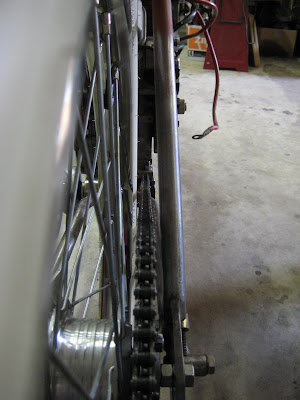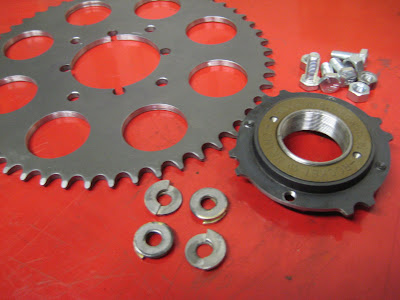
First I should say I'm not the happiest with these results but from 10' it'll look killer! These are the "engine plates" I made earlier. I knew I would be doing this to them since the beginning.
Engine turning is one of many names (all somewhat incorrect for this application) referring to a decorative overlapping pattern of swirls. True engine turning involves cams and precise lathes and good eyesight and is seen mostly in fine watches. The layman's engine turning is no less attractive and can be found on many vintage race cars and is maybe most popularly known from the Spirit of St Louis cowling.

There is a lot of info out there but practice is about all you can do. Those who say it's simple are likely happy with anything they get 'cause this isn't a cinch. It is mechanically easy to attempt but just not easy to get perfect results.
First you need the base metal as shiny as is reasonable. I have experimented a bit and every shortcut seams to cut into your final results and you can't go back on this stuff.

You have to play a bit. Some use lubricants, some use lapping compound, some use wooden dowels, some cork, and some use Cratex sticks. 3M pads for some, wet-dry sandpaper for others. You see what I mean?
I wasn't happy with the dowels, corks, or mounted Cratex stick. I used a stainless crimped end wire cup brush. Recommendations are to use a stainless brush with a very fine wire (.06). If you can encapsulate the wires all the way down to their ends all the better to keep them from spreading out under pressure. I used a zip tie and some masking tape.
As far as spacing, there are many patterns. Again you have to experiment. I chose to overlap about 1/3 along the row and about the same between each row. You also have to offset each row by a chosen amount. I went with 1/2 the distance used between each circle. Looking at the pics, I would go with a little more offset next time. That tends to give more of a diagonal pattern. There are indicator jigs people use on a drill press but I used a mill. Once set you have to apply equal pressure with each disk. I started dry then added some 40wt oil about half way through on one side and added WD40 after one row on the second side. I used 360RPM on one side and 930RPM on the second but 1100+ is recommended for aluminum. I got different results but they all showed "ghosting" and some galling where patterns overlapped. I think I was going a bit deep.
Here's what it will look like on the bike:

And from a distance:

 First I should say I'm not the happiest with these results but from 10' it'll look killer! These are the "engine plates" I made earlier. I knew I would be doing this to them since the beginning.
Engine turning is one of many names (all somewhat incorrect for this application) referring to a decorative overlapping pattern of swirls. True engine turning involves cams and precise lathes and good eyesight and is seen mostly in fine watches. The layman's engine turning is no less attractive and can be found on many vintage race cars and is maybe most popularly known from the Spirit of St Louis cowling.
First I should say I'm not the happiest with these results but from 10' it'll look killer! These are the "engine plates" I made earlier. I knew I would be doing this to them since the beginning.
Engine turning is one of many names (all somewhat incorrect for this application) referring to a decorative overlapping pattern of swirls. True engine turning involves cams and precise lathes and good eyesight and is seen mostly in fine watches. The layman's engine turning is no less attractive and can be found on many vintage race cars and is maybe most popularly known from the Spirit of St Louis cowling. There is a lot of info out there but practice is about all you can do. Those who say it's simple are likely happy with anything they get 'cause this isn't a cinch. It is mechanically easy to attempt but just not easy to get perfect results.
First you need the base metal as shiny as is reasonable. I have experimented a bit and every shortcut seams to cut into your final results and you can't go back on this stuff.
There is a lot of info out there but practice is about all you can do. Those who say it's simple are likely happy with anything they get 'cause this isn't a cinch. It is mechanically easy to attempt but just not easy to get perfect results.
First you need the base metal as shiny as is reasonable. I have experimented a bit and every shortcut seams to cut into your final results and you can't go back on this stuff.
 You have to play a bit. Some use lubricants, some use lapping compound, some use wooden dowels, some cork, and some use Cratex sticks. 3M pads for some, wet-dry sandpaper for others. You see what I mean?
I wasn't happy with the dowels, corks, or mounted Cratex stick. I used a stainless crimped end wire cup brush. Recommendations are to use a stainless brush with a very fine wire (.06). If you can encapsulate the wires all the way down to their ends all the better to keep them from spreading out under pressure. I used a zip tie and some masking tape.
As far as spacing, there are many patterns. Again you have to experiment. I chose to overlap about 1/3 along the row and about the same between each row. You also have to offset each row by a chosen amount. I went with 1/2 the distance used between each circle. Looking at the pics, I would go with a little more offset next time. That tends to give more of a diagonal pattern. There are indicator jigs people use on a drill press but I used a mill. Once set you have to apply equal pressure with each disk. I started dry then added some 40wt oil about half way through on one side and added WD40 after one row on the second side. I used 360RPM on one side and 930RPM on the second but 1100+ is recommended for aluminum. I got different results but they all showed "ghosting" and some galling where patterns overlapped. I think I was going a bit deep.
Here's what it will look like on the bike:
You have to play a bit. Some use lubricants, some use lapping compound, some use wooden dowels, some cork, and some use Cratex sticks. 3M pads for some, wet-dry sandpaper for others. You see what I mean?
I wasn't happy with the dowels, corks, or mounted Cratex stick. I used a stainless crimped end wire cup brush. Recommendations are to use a stainless brush with a very fine wire (.06). If you can encapsulate the wires all the way down to their ends all the better to keep them from spreading out under pressure. I used a zip tie and some masking tape.
As far as spacing, there are many patterns. Again you have to experiment. I chose to overlap about 1/3 along the row and about the same between each row. You also have to offset each row by a chosen amount. I went with 1/2 the distance used between each circle. Looking at the pics, I would go with a little more offset next time. That tends to give more of a diagonal pattern. There are indicator jigs people use on a drill press but I used a mill. Once set you have to apply equal pressure with each disk. I started dry then added some 40wt oil about half way through on one side and added WD40 after one row on the second side. I used 360RPM on one side and 930RPM on the second but 1100+ is recommended for aluminum. I got different results but they all showed "ghosting" and some galling where patterns overlapped. I think I was going a bit deep.
Here's what it will look like on the bike:
 And from a distance:
And from a distance:











